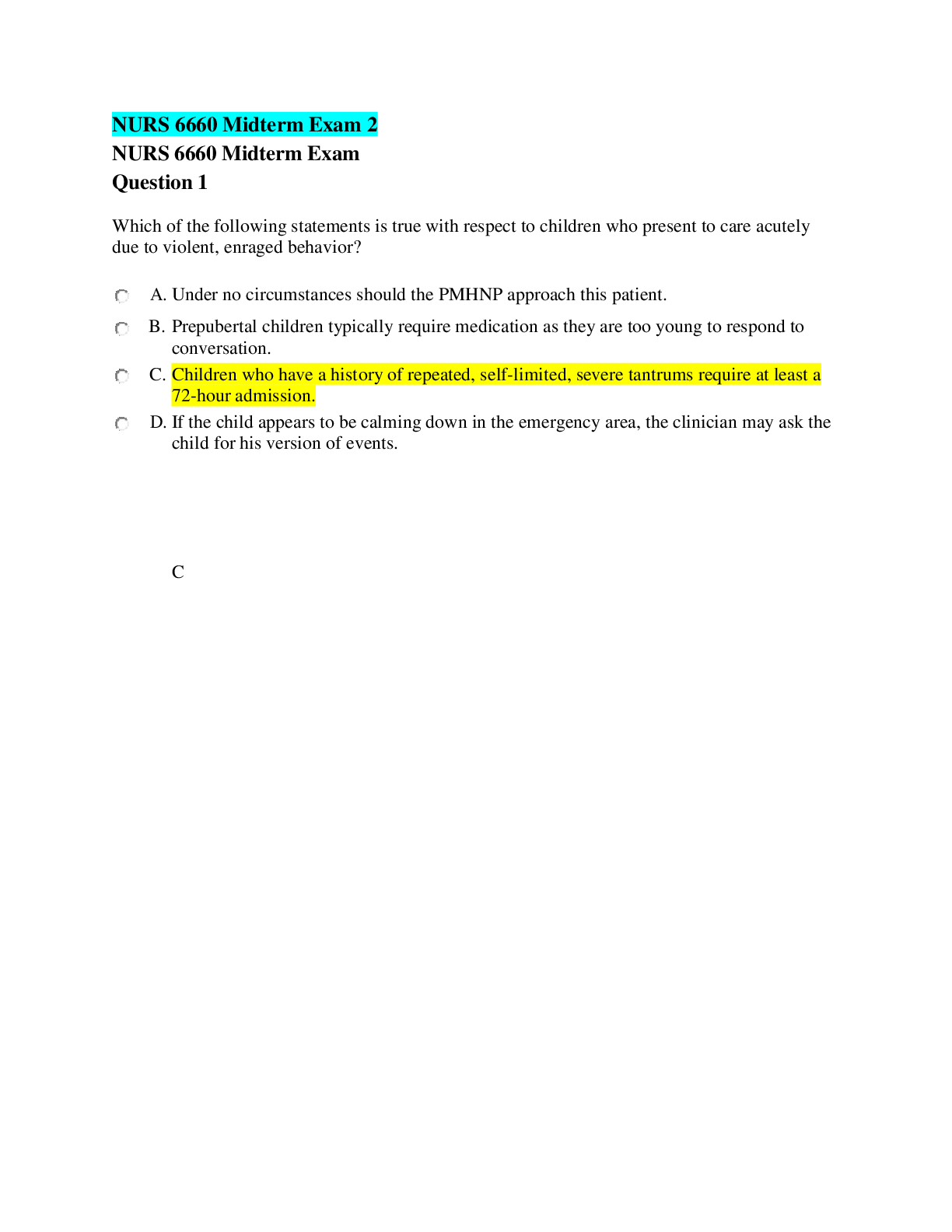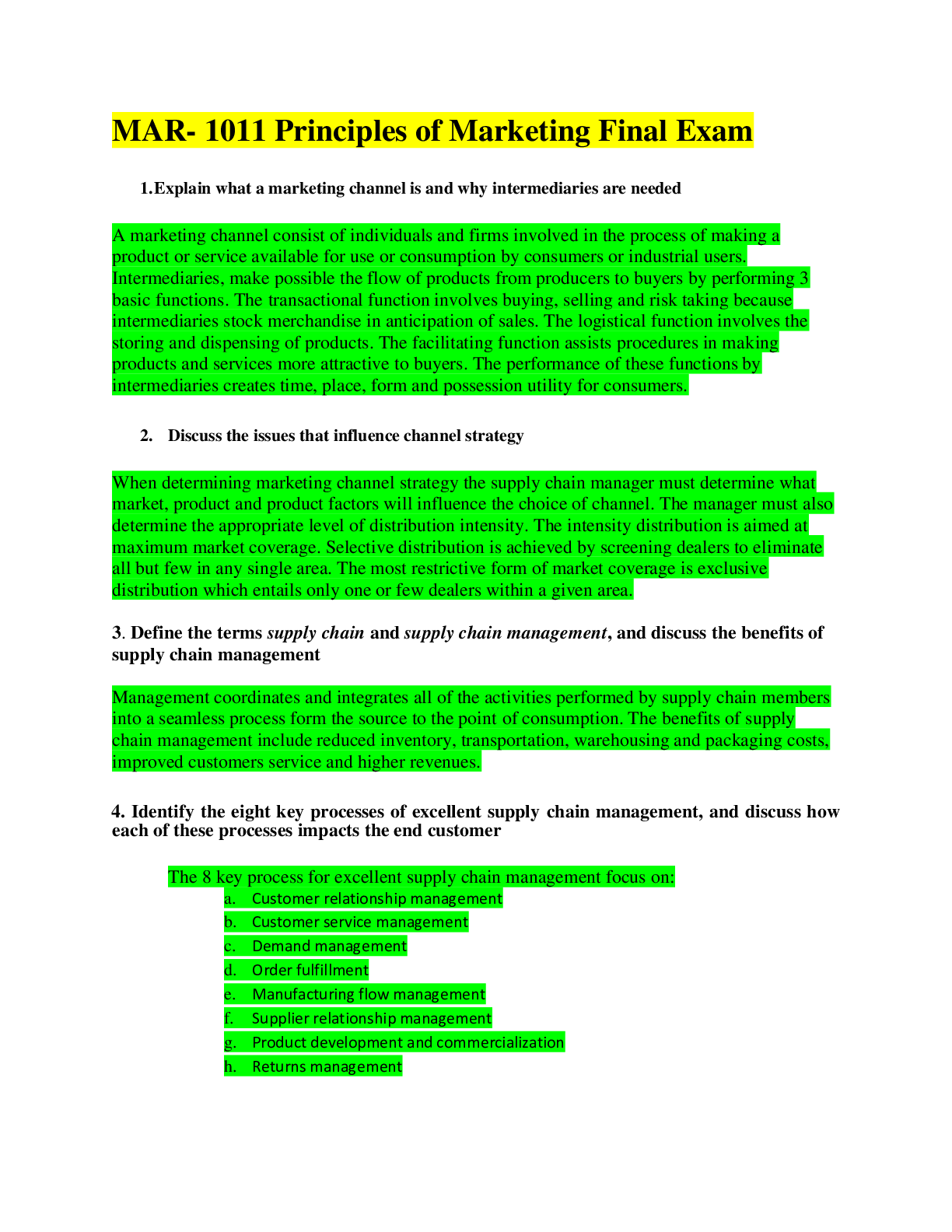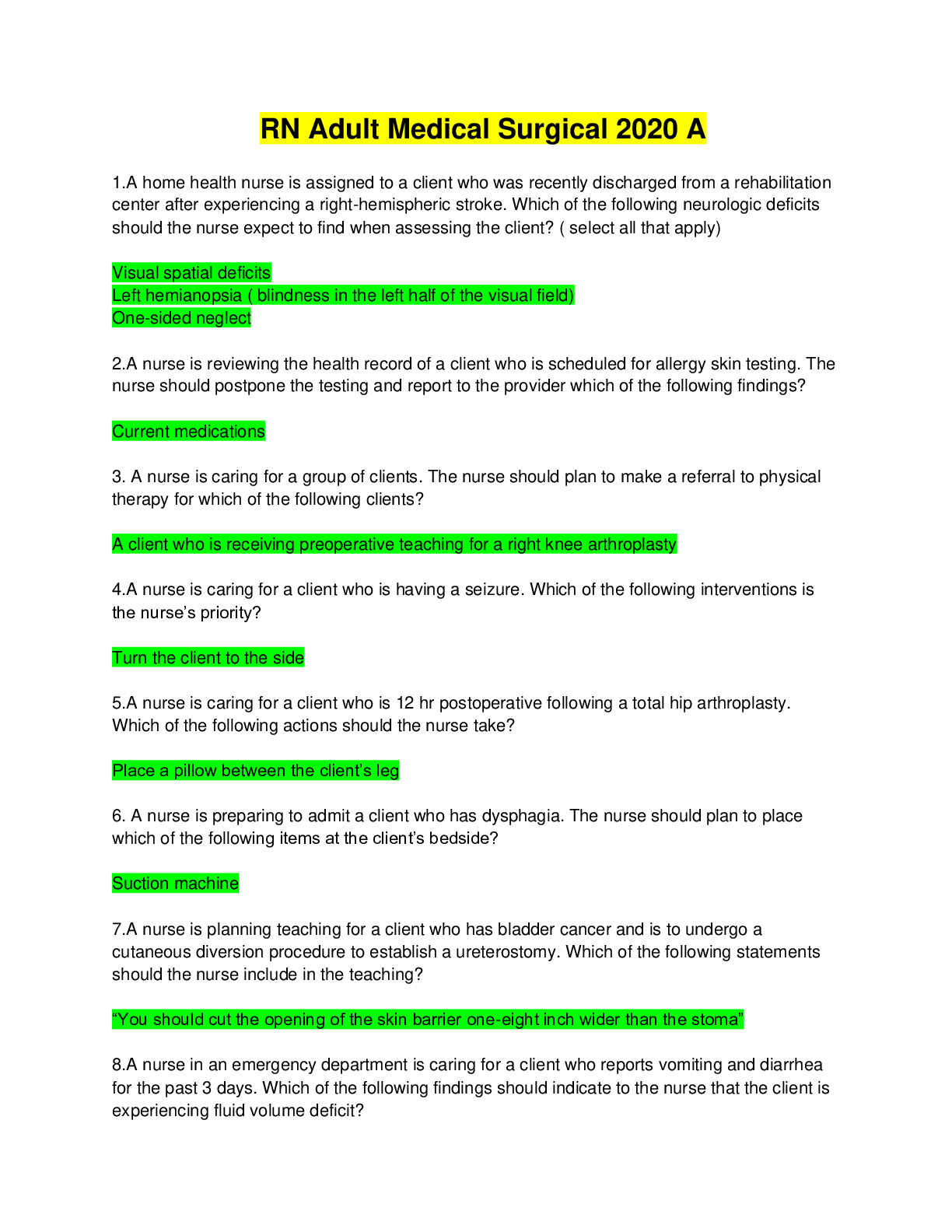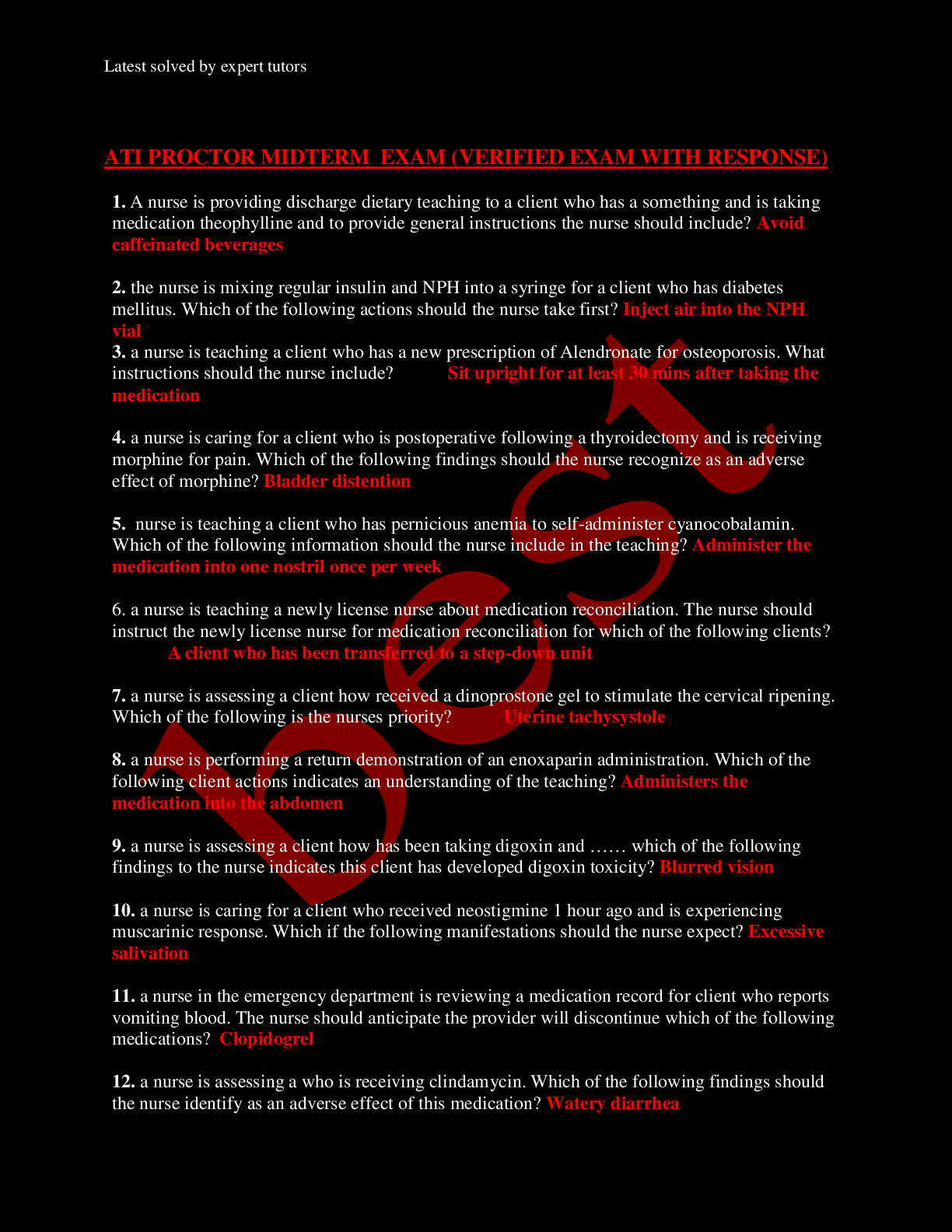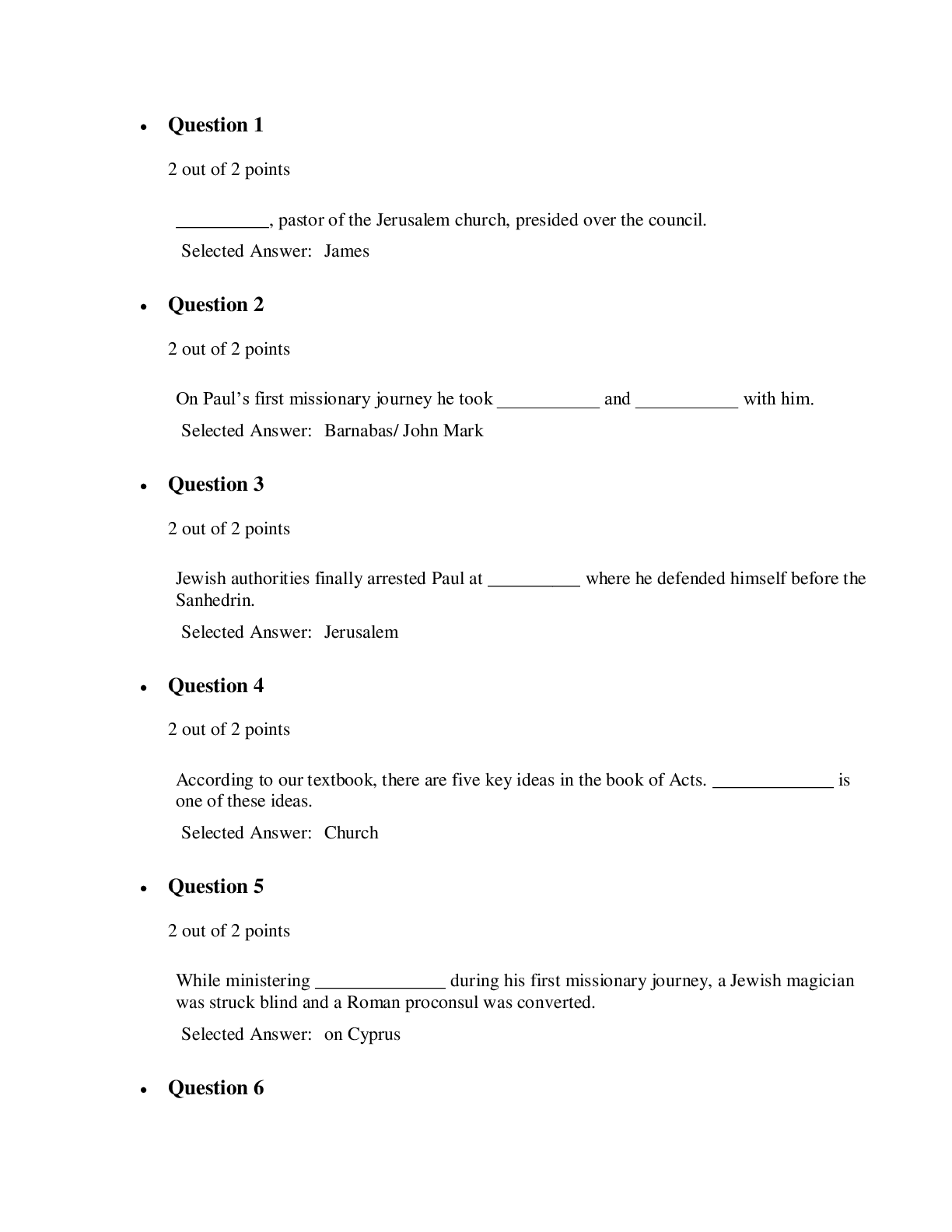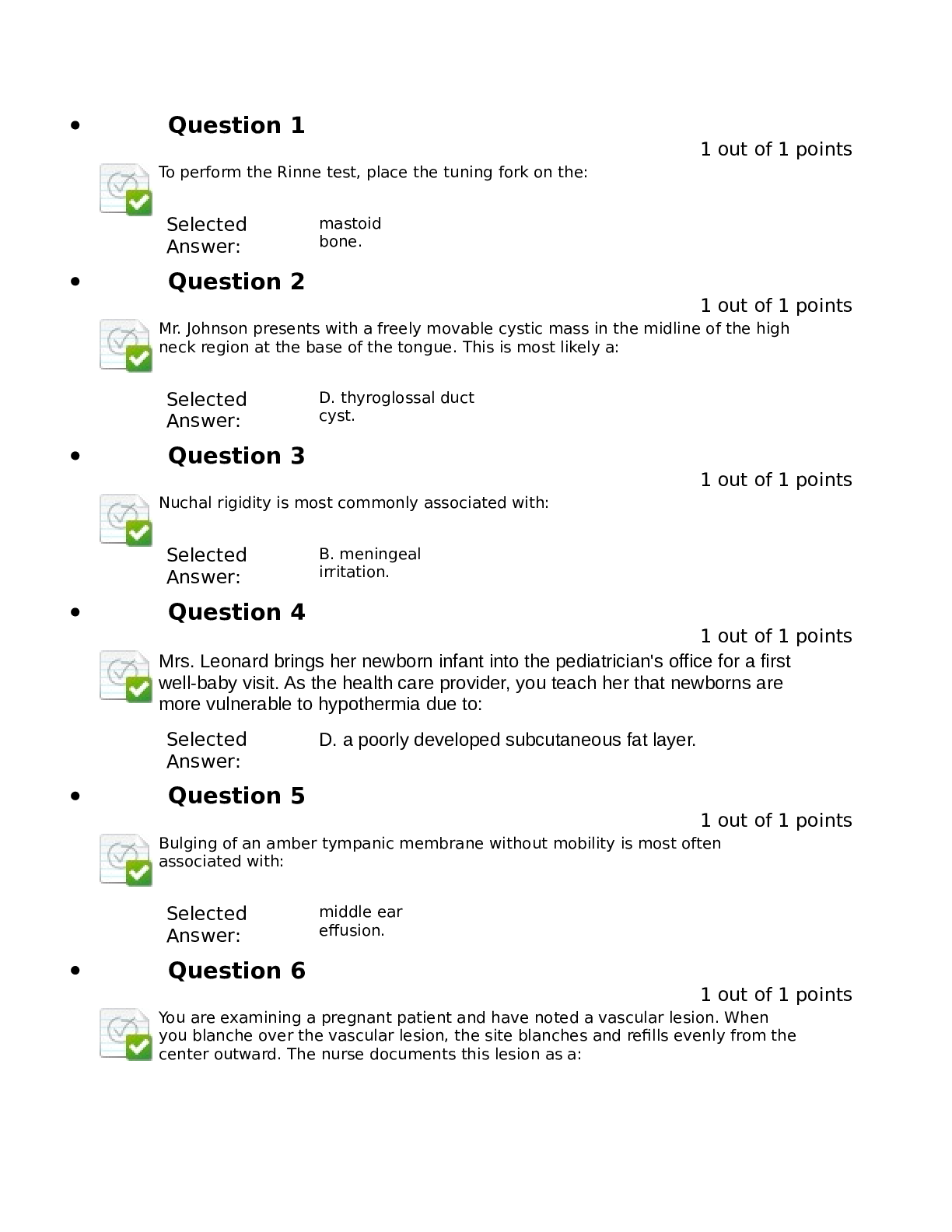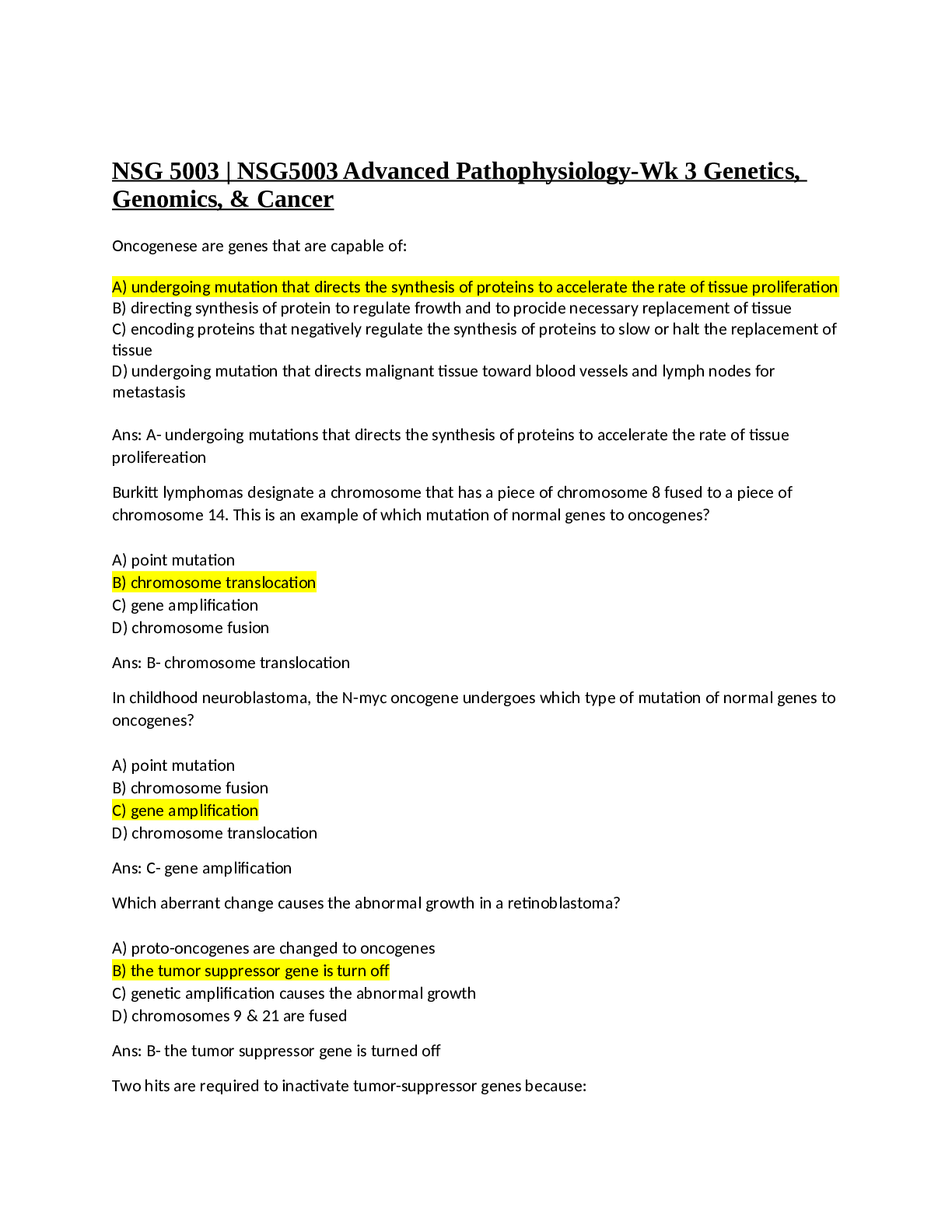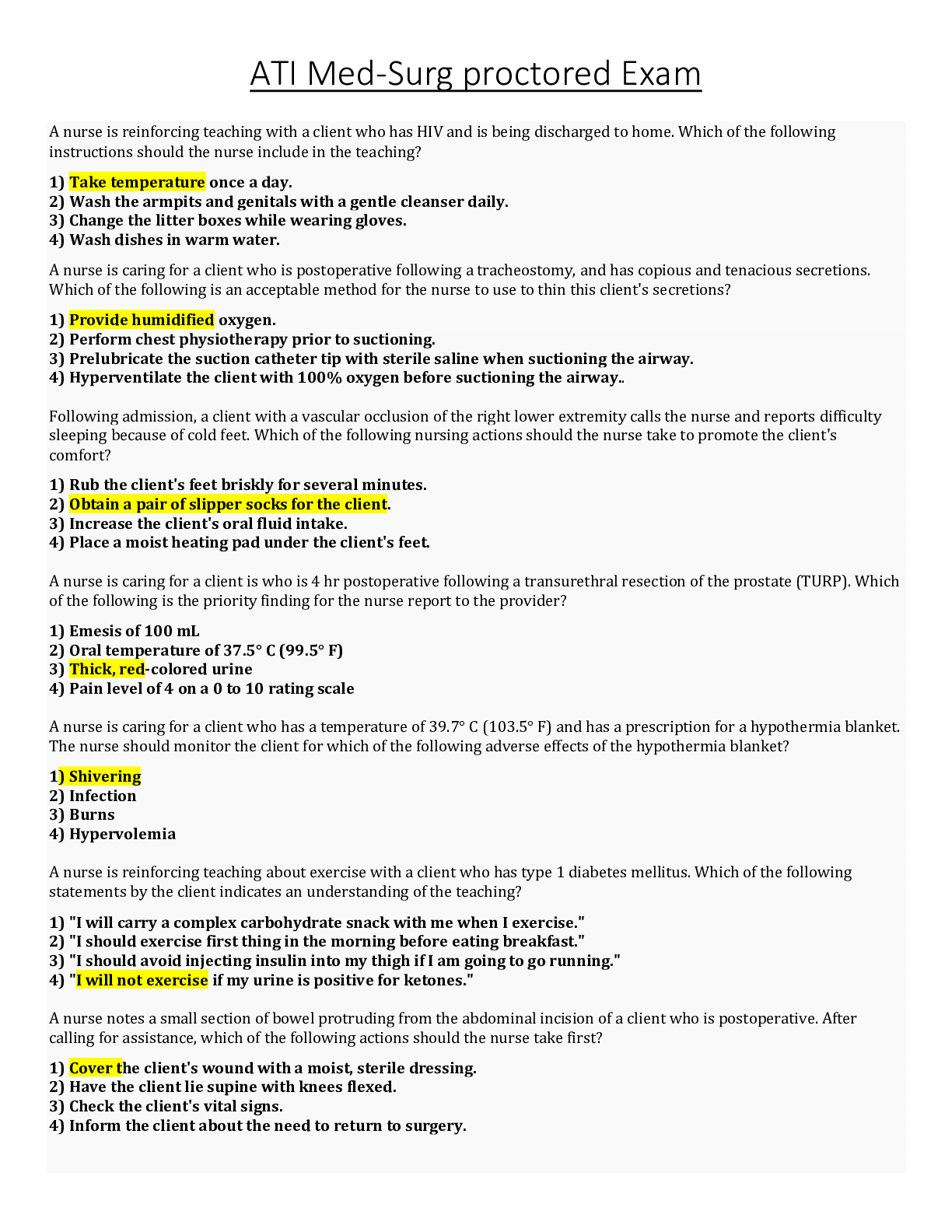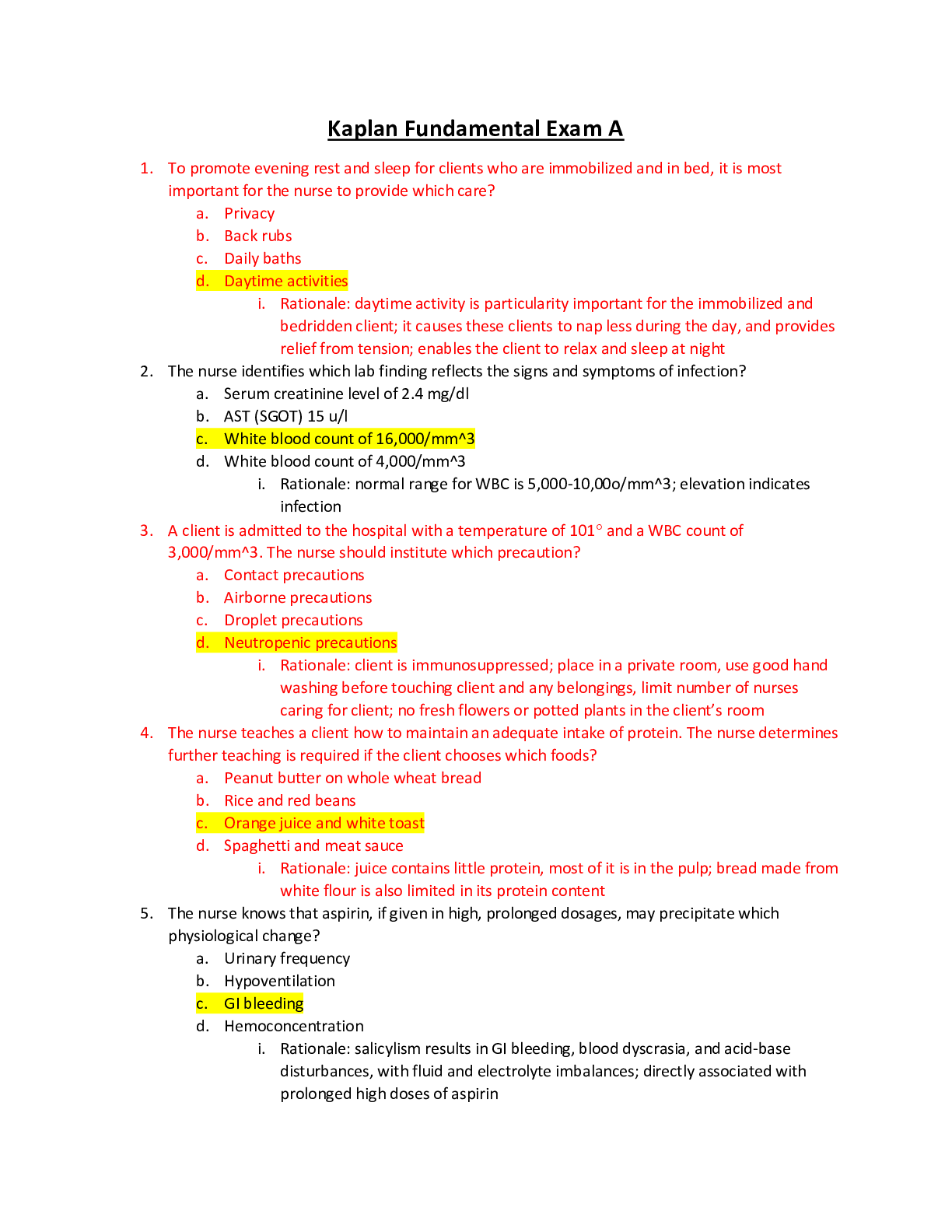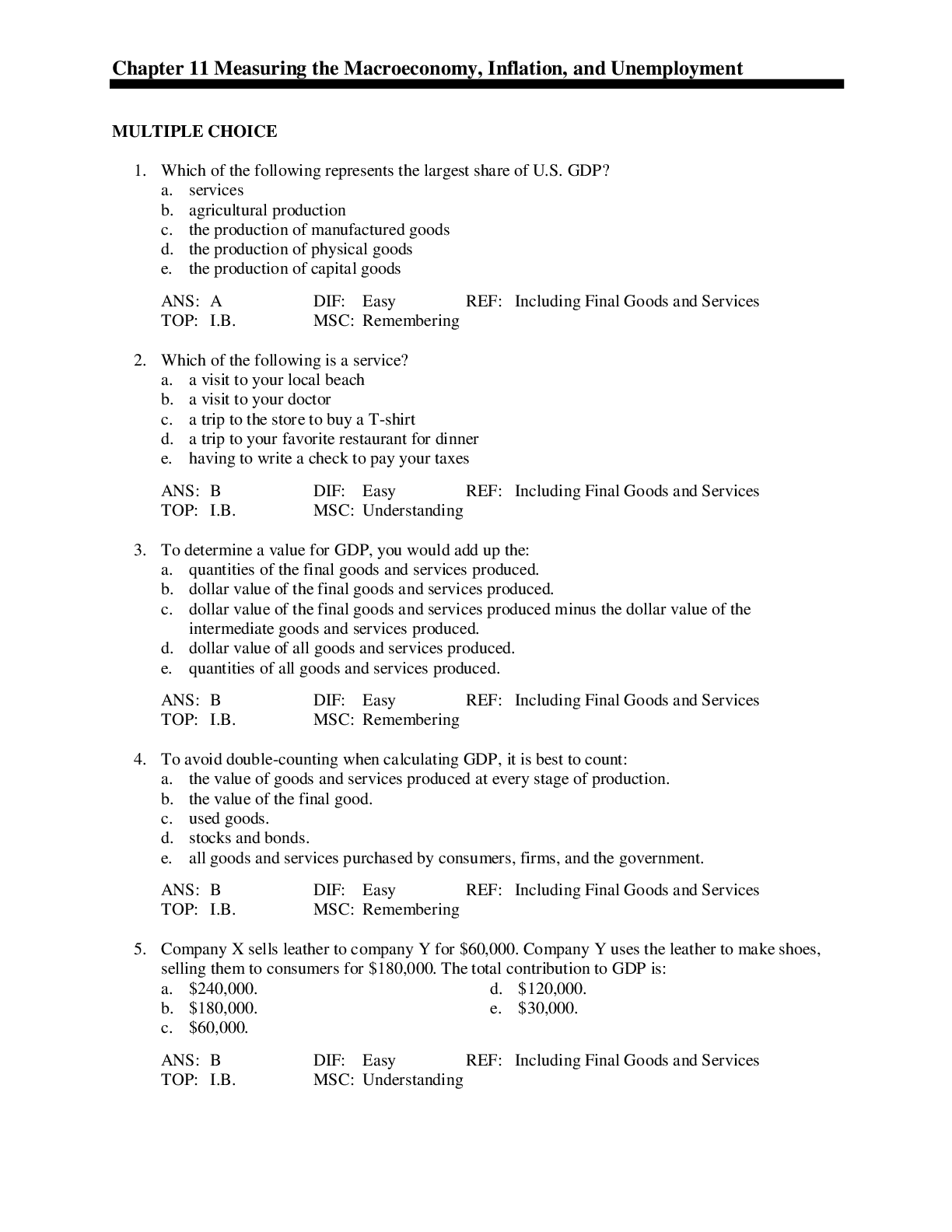Counseling > EXAM > CEFS546 – Quiz 1 40/40 complete questions and answers (All)
CEFS546 – Quiz 1 40/40 complete questions and answers
Document Content and Description Below
CEFS546 – Quiz 1 40/40 • Question 1 Culture shapes all of the following EXCEPT: Selected Answer: d. etiology of the symptoms. Answers: a. language used to describe symptoms. b. expression of... symptoms. c. commonness of the symptoms. d. etiology of the symptoms. • Question 2 Juan wants to do a research study on whether or not studying for a test will improve students’ performance. If he believes it will, what would be his hypothesis? Selected Answer: c. Students who study will perform better on the test. Answers: a. Will studying improve test performance? b. Will those who don’t study perform worse than those who do? c. Students who study will perform better on the test. d. All of the above • Question 3 Which of the following is NOT a characteristic of stigma? Selected Answer: b. A label applied to a group of people that breaks the law. Answers: a. A label applied to a group of people that distinguishes them from others. b. A label applied to a group of people that breaks the law. c. The label is linked to deviant or undesirable attributes by society. d. People with the label face unfair discrimination. • Question 4 Some critics of the DSM-5 believe that Selected Answer: b. the DSM-5 has pathologized too many problems without good justification. Answers: a. there are not enough different diagnoses.CEFS546 – Quiz 1 40/40 b. the DSM-5 has pathologized too many problems without good justification. c. there is not enough comorbidity in diagnoses. d. another diagnostic category should be added titled “Conditions that may be a focus of clinical attention in elderly populations.” • Question 5 1.6 out of 1.6 points The best definition of mental disorder takes all of the following into account EXCEPT: Selected Answer: d. syndromes Answers: a. personal distress. b. violation of social norms c. disability d. syndromes • Question 6 Systematically rewarding desirable behavior and extinguishing undesirable behavior is the centerpiece of which behavioral theory? Selected Answer: a. Operant conditioning Answers: a. Operant conditioning b. Systematic conditioning c. Classical conditioning d. Observational conditioning • Question 7 According to behavior genetics research, Selected Answer: a. nonshared experiences have much more to do with mental illness than shared experiences. Answers: a. nonshared experiences have much more to do with mental illness than shared experiences. b. shared experiences have much more to do with mental illness than nonshared experiences. c. shared and nonshared experiences are equally important for mental illness.CEFS546 – Quiz 1 40/40 d. there is no way to differentiate between shared and nonshared contributions to mental illness. • Question 8 Which research design is illustrated by the following? A therapist gathers data showing that, repeatedly, a patient is better on days his wife visits and worse on days when she does not. Selected Answer: b. correlational method Answers: a. observation b. correlational method c. single-subject (ABAB) experiment d. longitudinal design • Question 9 Diane has repetitive thoughts that her house will catch on fire. She repeatedly checks the stove to make sure it is turned off. Diane’s compulsive behavior serves to Selected Answer: d. all of the above. Answers: a. provide immediate relief from the anxiety associated with her repetitive thoughts. b. reinforce her checking behaviors. c. lower her psychophysiological arousal. d. all of the above. • Question 10 The first goal of family-focused treatment is to Selected Answer: a. provide psychoeducation. Answers: a. provide psychoeducation. b. choose one problem to address. c. generate potential solutions. d. symptom management. • Question 11 1.6 out of 1.6 points Edna does not currently have panic disorder. However, she cannot leave her house and had required home sessions when she began therapy. It is likely that Selected Answer: a. Edna has agoraphobia, but does not meet criteria for panic disorder.CEFS546 – Quiz 1 40/40 Answers: a. Edna has agoraphobia, but does not meet criteria for panic disorder. b. Edna does not have agoraphobia. c. Edna is faking her symptoms. d. Edna has more severe panic but is able to cope with the symptoms. • Question 12 1.6 out of 1.6 points Studies of psychopathology among different cultures and ethnicities have shown that eating disorders are more common among , while schizophrenia is more common among . Selected Answer: c. Caucasians; African-Americans Answers: a. African-Americans; Caucasians b. Hispanics; Caucasians c. Caucasians; African-Americans d. African-Americans; Hispanics • Question 13 One way in which the DSM-5 differs from the DSM-IV-TR is that the DSM-5 Selected Answer: b. makes OCD and trauma-related disorders their own category. Answers: a. makes OCD and trauma-related disorders part of the anxiety disorders category. b. makes OCD and trauma-related disorders their own category. c. eliminates OCD and trauma-related disorders. d. none of the above. • Question 14 Dr. Jones encourages her clients, under hypnosis, to recall childhood traumas and the emotions associated with them. This technique was developed by Selected Answer: a. Josef Breuer. Answers: a. Josef Breuer. b. Carl Jung.CEFS546 – Quiz 1 40/40 c. Fritz Perls. d. Franz Mesmer. • Question 15 What percentage of people who develop Post -Traumatic Stress Disorder have a history of an anxiety disorder? Selected Answer: d. 66%. Answers: a. 15%. b. 46%. c. 52% d. 66%. • Question 16 Julie has social anxiety disorder. Given this information, it would not be surprising if she also met DSM-5 criteria for Selected Answer: c. avoidant personality disorder. Answers: a. schizophrenia. b. borderline personality disorder. c. avoidant personality disorder. d. obsessive compulsive personality disorder. • Question 17 Women are more likely to be diagnosed with anxiety disorders because they are more Selected Answer: c. willing to report their symptoms. Answers: a. likely to face their fears directly. b. physiologically vulnerable. c. willing to report their symptoms. d. exposed to social discrimination. • Question 18 Intrusive, irrational, and unwanted thoughts are called Selected Answer: c. obsessions. Answers: a. irrational beliefs.CEFS546 – Quiz 1 40/40 b. generalized anxiety. c. obsessions. d. compulsions. • Question 19 Hippocrates’ early views on mental health contributed to an enduring emphasis on Selected Answer: a. natural causes Answers: a. natural causes b. spirituality c. humors d. classification • Question 20 Generally, it is impossible for measures to be Selected Answer: b. valid but not reliable. Answers: a. reliable but not valid. b. valid but not reliable. c. neither reliable nor valid. d. both reliable and valid. • Question 21 Which of the following statements is TRUE? Selected Answer: a. Culture can have a large influence on which symptoms of a given disorder are expressed. Answers: a. Culture can have a large influence on which symptoms of a given disorder are expressed. b. For most diagnoses in the DSM-5, it is advised not to consider cultural context. c. All symptoms of psychiatric disorders manifest themselves in similar ways across cultures. d. The DSM-II was the first edition of the DSM to consider cultural and ethnic variations in psychopathology. • Question 22CEFS546 – Quiz 1 40/40 Dr. Kline classified her patients according to hair color. Some were classified as blonde, some brunette, and some red haired. This classification is an example of a Selected Answer: c. categorical classification Answers: a. continuous classification. b. etiological classification. c. categorical classification d. dimensional classification • Question 23 Which of the following scientific methods uses random assignment? Selected Answer: d. experiment Answers: a. correlation b. case study c. realistic d. experiment • Question 24 People who compulsively check their appearance and spend countless hours staring at themselves in the mirror will likely be diagnosed as having Selected Answer: b. body dysmorphic disorder Answers: a. obsessive-compulsive disorder b. body dysmorphic disorder c. generalized anxiety disorder d. specific phobia The most common disorder comorbid with anxiety disorders is Selected Answer: d. major depression Answers: a. borderline personality disorder. b. obsessive compulsive disorder. c. avoidant personality disorder d. major depression • Question 25CEFS546 – Quiz 1 40/40 [Show More]
Last updated: 2 years ago
Preview 1 out of 8 pages

Buy this document to get the full access instantly
Instant Download Access after purchase
Buy NowInstant download
We Accept:

Reviews( 0 )
$13.00
Can't find what you want? Try our AI powered Search
Document information
Connected school, study & course
About the document
Uploaded On
Sep 13, 2021
Number of pages
8
Written in
Additional information
This document has been written for:
Uploaded
Sep 13, 2021
Downloads
0
Views
55



